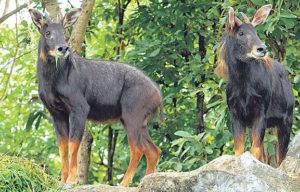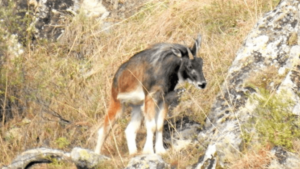A Himalayan serow has been sighted for the first time in the Himalayan cold desert region. Why is the sighting significant?
First, what kind of an animal is the Himalayan serow?
A biologist has decribed a Himalayan serow as resembling a cross between a goat, a donkey, a cow, and a pig. It’s a medium-sized mammal with a large head, thick neck, short limbs, long, mule-like ears, and a coat of dark hair.

Himalayan serows are herbivores, and are typically found at altitudes between 2,000 metres and 4,000 metres (6,500 to 13,000 feet). They are known to be found in eastern, central, and western Himalayas, but not in the Trans Himalayan region.
So where has this serow been sighted?
The animal was spotted by locals and wildlife officials at a riverside rocky wall near Hurling village in Spiti, Himachal Pradesh, on Friday (December 11). It was again sighted in the area on Sunday (December 13).
This is the first recorded human sighting of the serow in Himachal Pradesh. The animal has been spotted a few times earlier in the state, but that has always been through camera traps.
Why is the sighting of the serow unusual?
Spiti lies in the cold mountain desert region of the western Himalaya, and its valley floor has an average elevation of 4,270 metres above sea level.
Serows are generally not found at this altitude, and never before has a serow been seen in the Himalayan cold desert. Wildlife officials believe this particular animal may have strayed into the Spiti valley from the Rupi Bhaba Wildlife Sanctuary in adjoining Kinnaur.
Ajit Thakur, director of the Great Himalayan National Park in Kullu where serows have previously been spotted, said he was surprised that a serow had been photographed from close range.
“It is otherwise a very elusive animal, and few people have ever caught so much as a glimpse of it. We have been frantically trying to spot serows in the national park for the last 10-12 years, and have so far managed only two sightings through camera traps in the Tirthan valley,” he said.
The animal has also been spotted in the Rupi Bhaba Wildlife Sanctuary, and in the higher reaches of Chamba.

Is the serow a threatened or endangered species?
According to the International Union for Conservation of Nature (IUCN), Himalayan serows have experienced significant declines in population size, range size and habitat in the last decade, and this is expected to continue due to intensive human impact.
Previously assessed as ‘near threatened’, the Himalayan serow is now been categorised as ‘vulnerable’ in the IUCN Red List of Threatened Species.
It is listed under Schedule I of The Wildlife Protection Act, 1972, which provides absolute protection.
So, what now for the serow in Spiti?
Divisional forest officer Hardev Negi said that wildlife officials are trying to monitor the movement of the animal, and keep it safe from stray dogs.
Himalayan serows are solitary by nature, and even though it has been sighted twice, it is “too clever” to be caught for rescue purposes, he said.

